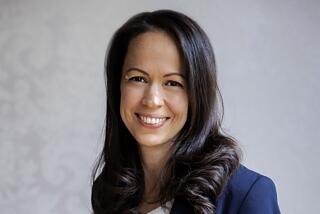Buzzword Is Losing Its Essential Qualities
In the old days, transparency was simple. Glass was transparent and motives were transparent. Photographic negatives were transparent and so were modish raincoats--the kind you could imagine Twiggy in, sashaying around swinging London.
Transparency was a window onto what was previously hidden, and the more you saw, the more you understood, or thought you understood. Seeing, as they say, was believing, and seeing through something was the ultimate expression of power and enlightenment, like Superman with his X-ray eyes.
“The idea of seeking transparency and the ability to see through illusions is the central idea of philosophy and science. That’s true of the Eastern tradition and the Western tradition,” says Ken Sanes, a former editorial writer for the Palm Beach Post who operates www.transpa rencynow.com, an Internet Web site “devoted to making things clearer.”
But now transparency is becoming complex and evasive, even as its linguistic stock soars. On Capitol Hill, legislators are calling for more “transparency” in corporate America following the Enron debacle, in which company executives allegedly played hide-and-seek with other people’s money. President Bush recently declared that the United States “cannot allow nations that aren’t transparent,” i.e. brutal dictatorships, to join forces with terrorist groups. A few weeks ago, a spokeswoman for India’s Foreign Ministry, downplaying a recent short-range missile test that could have threatened Pakistan, insisted that “the test was undertaken in a predictable and transparent manner.” And the International Olympic Committee has vowed to be more “transparent” in its affairs after a series of scandals on and off the ice.
This raises some obvious questions: Why “transparent” instead of an old-fashioned, forthright adjective such as “honest” or “open”? What meanings may lie beneath transparency’s smooth, euphemistic surface? And why is transparent so visible these days?
It could be that, to anyone with his or her eyes open, concepts such as “honesty,” “openness” and even “reality” have become rather opaque lately. “Transparent” captures the sense of ambiguity that pervades postmodern life--the uneasy feeling that, when we try to perceive the world around us or sift facts from virtual simulations, there’s no solid there there anymore. Even the world’s most wanted man, Osama bin Laden, has somehow managed to temporarily slip out of view, despite the presence of hundreds of electronic camera eyes, satellites and infra-red scopes trying desperately to spot him. “Transparent” may inadvertently express the uneasy, very contemporary feeling that the harder we stare at things, the less we see.
Transparency’s unsettling faddishness isn’t confined to politics, business and sports. It has infiltrated food, fashion, design and architecture, as both metaphor and motif. Classic iMac computers are transparent, and Nepalese “ping” noodles are transparent. Odorless, overpriced soap is transparent, and the new Prada boutique in Manhattan, designed by the visibly talented Dutch architect Rem Koolhaas, contains changing rooms with transparent glass facades that can be made dark or peekaboo at the flick of a button.
Meanwhile, there’s a movement afoot to make public spaces--airports, basketball arenas, government buildings--more transparent, using security cameras and other high-tech surveillance to catch terrorists and “evildoers,” some of whom may be hiding among us in plain sight.
The use of “transparent” and “transparency” also may reflect anxiety over issues such as Internet privacy, the security (or lack thereof) of “wireless technology,” the spread of “identity theft” and the questionable reliability of information during wartime. “Transparent” carries a variety of encoded meanings in a society where self-display and exhibitionism are commonplace. Some think America is becoming a nation not of visionaries but voyeurs, whose tastes and modes of perception are being modeled after a Victoria’s Secret catalog. After all, when Henry David Thoreau wrote, “A man must see before he can say,” he probably was referring to spiritual learning, not lingerie.
For some time, it’s been all too apparent that “transparent” is a slippery term, a looking-glass word with a dual personality. Most of the time it denotes frankness, honesty, accountability--clearly what President Bush meant in his recent remarks about rogue states. But it can signal ugly deceptions masquerading as truth. To say that someone’s motives are “transparent” is basically to call him or her a lousy liar.
Especially in visually sophisticated societies such as the United States, the idea of transparency is being undercut by the recognition that images distort, photographs can be digitally tweaked and reality can be virtually constructed out of pixels. The action of seeing, of sight itself, has been both enhanced and, some argue, undermined by the proliferation of new visual technologies--everything from high-powered telescopes and Hollywood special effects to camera-assisted surgery equipment--that allow us to see in spectacular new ways but make us distrust our own eyes.
“All the common linguistic tropes we use--’seeing is believing,’ ‘transparency’--that we use to express truth have been destabilized very much [over] the last decade,” says Nicholas Mirzoeff, a professor in the art department at the State University of New York at Stony Brook and editor of “The Visual Culture Reader” (Routledge, 1998).
We now know that powerful people and institutions can veil their machinations with doctored photos, trumped-up accounting figures, falsified body counts. That perception could make it hard for today’s leaders to reassure the public by pledging that their future actions will be more “transparent.” “People are used to seeing in the rest of our everyday lives how fluid and manipulable things are,” Mirzoeff says. “Images can be manipulated by people using the simplest point-and-click technology. So the metaphor [of transparency] ceases to be convincing.”
These days there’s reason to think that all visually related figures of speech should be treated as suspect until proven innocent. According to published remarks, some Enron executives were fond of referring to the “optics” and the “cosmetics” of a deal, i.e. the appearance, not the reality, of its chances for success. Before its collapse, how Enron looked to outsiders was considered more important than how it actually performed. Enron appears to have been the Dorian Gray of corporations, turning a handsome profile to Wall Street while its alter-ego’s visage rotted away in the attic.
In the multilayered world of our contemporary lives, where we see ourselves endlessly reflected in ATM screens, home videos, the Staples Center scoreboard, the challenge is knowing how to remove the veils so we can see when lies are being told, account books are being cooked and the emperor has no clothes. Science-fiction author David Brin (“The Postman”) argues in his nonfiction book “The Transparent Society: Freedom Versus Privacy in a City of Glass Houses” that the best way to secure a truly see-through America is to make sure that the citizenry, in effect, has the same access to X-ray specs as the powers that be.
“In all of human history, no government ever knew as much about its people as our government does, and no people in history has ever been so free,” says Brin, speaking by phone from his home in Southern California. “What do you do with a paradox like that?”
You can shrug it off, Brin argues, or you can turn it into an asset. “Having a government that sees better is not unreasonable,” he says. “What’s reasonable is stripping it naked. And that holds for the private sector as well. Because human beings will do what human beings do: Given some power, they will try to conceal and protect their interests. Given a choice between accountability and privacy, we can reliably be expected to choose one for ourselves and the other for everyone else.”
Transparently, he’s right.
More to Read
The biggest entertainment stories
Get our big stories about Hollywood, film, television, music, arts, culture and more right in your inbox as soon as they publish.
You may occasionally receive promotional content from the Los Angeles Times.











